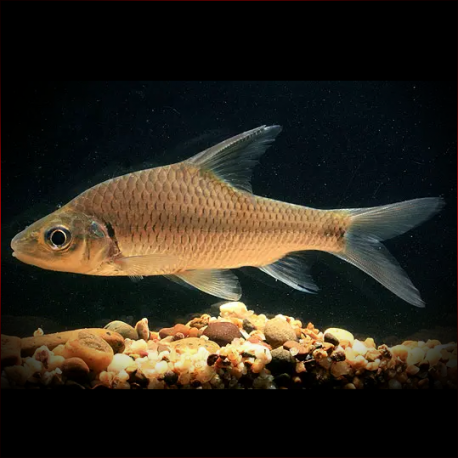More info
Datasheet
| Minimum Tank Size | 370 litres / 97.74 US gallons |
| Maximum Size | 28.0cm / 11.02inches |
| Temperature | 20°C / 68.00°F - 26°C / 78.80°F |
| Hardness | 1.01dgH / 18ppm - 20.00dgH / 357ppm |
| pH | 5.0-8.0 |
General Description
Cyclocheilichthys Repasson, commonly known as the C. repasson, is a species belonging to the Cyprinidae family. This fish species is characterized by possessing a serrated dorsal fin spine, a conical snout, small, subterminal mouth, and parallel rows of sensory folds on the snout and cheeks. It typically displays a dark spot on the caudal peduncle and longitudinal stripes formed by dark markings on individual scales, along with two pairs of barbels. The C. repasson can grow to a maximum size of 28.0cm and is primarily a riverine fish that prefers slower-moving or still zones, including swamps, lakes, canals, and ditches.
Aquarium Setup
For keeping C. repasson in captivity, it is advisable to provide a dimly-lit environment with a soft, sandy substrate. This species thrives in an aquarium setup that includes good-sized pieces of driftwood, providing shady patches appreciated by the fish. Suitable aquatic plant species for the tank setup may include Microsorum, Taxiphyllum, or potted Cryptocorynes spp., especially broad-leaved varieties that the fish grazes on for food. Additionally, incorporating floating vegetation aids in diffusing light entering the tank and contributes to a more natural ambiance. Specific water conditions such as a pH range of 5.0-8.0, hardness between 18-357ppm, and a temperature maintained at 20-26°C are conducive for the well-being of C. repasson in an aquarium environment.
Behaviour
The C. repasson is a gregarious species by nature and is best kept in groups of at least six individuals for optimal color display, decreased nervousness, and a more natural appearance. It thrives in larger, well-furnished community setups, where it can coexist with suitable tankmates such as cyprinids, loaches, cichlids, catfish, and characins. However, caution is advised when housing C. repasson with slow-moving or timid fish due to its size and potential to unsettle tank companions. The fish tend to exhibit better colors in the presence of conspecifics, displaying a more natural-looking behavior.
Feeding and Diet
In its natural habitat, C. repasson primarily feeds on insects, crustaceans, mollusks, algae, and other plant material. To replicate this diet in an aquarium setting, regular feeding with small live and frozen foods like bloodworms, Daphnia, and Artemia is recommended. Additionally, offering high-quality dried flakes and granules, along with meaty items such as chopped prawns and small earthworms for larger specimens, contributes to maintaining the fish's health and condition.
Reproduction & Dimorphism
As of current knowledge, breeding of C. repasson in aquarium settings has not been documented. In its natural habitat, the species spawns in flooded zones towards the end of the wet season. Sexually mature females of the C. repasson are likely to exhibit a thicker-bodied morphology compared to males, distinguishing sexual dimorphism in this fish species.
Habitat and Distribution
The C. repasson has an extensive natural range across regions extending from the Mekong region in Thailand, Laos, Cambodia, and Vietnam to Thailand, Myanmar, Peninsular Malaysia, and the Greater Sunda Islands of Borneo and Sumatra. It inhabits various river drainages, lakes, reservoirs, and smaller river basins, adapting to different localities with variations in coloration and patterning. The species preferentially resides in submerged tree roots, branches, and plant-rich habitats within riverine environments, although human activities have led to its presence in altered and permanent bodies of water.

